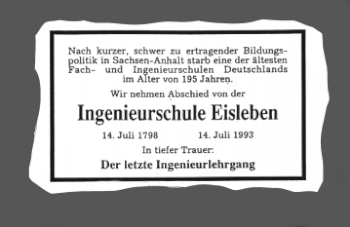Eisleben Engineering School
The Eisleben Engineering School is the direct successor to the Eisleben Mountain School . The sharp decline in mining in Europe, which did not stop at the GDR , made it necessary to consider the future fate of the traditional educational institution at the end of the 1960s. In view of the rapid development of microelectronics and computer technology and taking into account the greatly expanding field of mountain electrical engineering at the school, the government decided in 1968 to change the profile of the Eisleben mountain school to an engineering school for electrical engineering and mechanical engineering (Eisleben engineering school) and to phase out the mining training. In 1971, distance learning mining engineers were the last to leave the school.
The new profile of the school in 1971
- 9 seminar groups electronics in direct study
- 6 seminar groups engineering economists for electrical engineering in direct study
- 3 seminar groups electronics in distance learning
- 2 seminar groups engineering economists for electrical engineering in distance learning
- 3 seminar groups for specialist engineers and specialist economists
- 38 seminar groups at branch offices, mainly in distance learning
- Seminar groups for IT technicians
- Seminar groups for business economists
With great commitment from the teachers who remained at the school and with many new hires, Director Leithold formed a highly qualified teaching body consisting of many doctoral lecturers, who trained engineers for electrical engineering / electronics, mechanical engineering and engineering economists as well as materials managers with technical equipment that was excellent for GDR standards, who were gladly employed by the state's industry because of their good training and made a considerable contribution to the so-called "microelectronics program of the GDR". There were also postgraduate courses in the fields of microelectronics, occupational safety, work design and occupational safety, as well as computer science. An abundance of advanced training courses, nationally respected specialist conferences and participation in the engineering association " Chamber of Technology " round off the professional profile of these years. The school had a capacity of around 5000 students (direct, distance and evening courses).
Branch offices
Branch offices were set up in the heavy current plant construction companies in Berlin, Elektroprojekt Berlin, KWO Berlin, Funkwerk Köpenick, Robotron , Zentronik , semiconductor plant Frankfurt (Oder) and others. a.
Type of study
The engineering school trained its graduates in distance learning and direct study. A direct study lasted three years, the last (sixth) semester was carried out in practice - usually in the later employment company.
There were boarding schools for direct students
- Boarding school Wolferöder Weg
- Boarding school in Friedrichsberg (former foreign labor camp Neue Krughütte)
Requirements for studying
Requirements for enrollment were:
- good performance by completing 10th grade
- good performance in the skilled worker qualification
- 1 to 2 years of skilled work experience (exceptions for vocational training with a high school diploma)
Requirement for enrollment in the technician training
- Very good performance at the end of the 10th grade, as a technical diploma was part of the training
Despite the strict selection criteria, the de-registration rate was around 20 percent (mostly only in the basic study phase in the first year of study).
Advice and information center for microelectronics
An advisory and information center for microelectronics, which was initially established within the framework of the Chamber of Technology (KdT) , contributed significantly to the good professional reputation of the school from 1973 to 1990 through its industry-related research, which received several thousand graduates for the electrotechnical and electronic industry and for trained all areas of data processing.
After the reunification, this training ended in July 1993 with the de-registration of the last engineers.
In 1994 the last technicians were de-registered according to the GDR training curriculum and a final one-year internship.
Liquidation of the oldest engineering school in Germany
In the reorganization of the university landscape in Saxony-Anhalt at the beginning of the 1990s, the oldest engineering school in Germany was not taken into account despite the recognized very high level, existing premises and other very good conditions. For this purpose, a university of applied sciences with a similar profile was founded just 80 kilometers away. This is in the constituency of the then Prime Minister of Saxony-Anhalt .
In accordance with the education law of the state of Saxony-Anhalt, the former engineering school became a technical college for technology and business, which trains state-certified technicians for electronics, mechanical engineering and IT as well as state-certified business economists in a two-year direct study. In 1993, after 195 years, the school also lost its legal independence.
The last year of engineers expressed their sadness and horror at the demolition of the traditional facility with an advertisement on the day of de-registration, which happened to be the 195th birthday of the school.
Following the engineering studies, the state of Saxony-Anhalt offered to complete a one-year extension course at the newly founded FH Anhalt in Köthen. This ended with the job title Dipl.-Ing. (FH) and was accepted by most of the last graduates.
Hopes for the establishment of a professional academy were dashed, as there was no support for the model of a professional academy nor for the location from the respective state governments.
The building is now part of the vocational schools in the district of Mansfelder Land.
literature
- Boltz, Gerhard et al .: History of the Mountain School / Engineering School Eisleben 1928-1990 , Halle / Saale: Gursky, 1998, ISBN 3-929389-22-3
Coordinates: 51 ° 31 ′ 27 ″ N , 11 ° 33 ′ 14 ″ E

